Related Research Articles
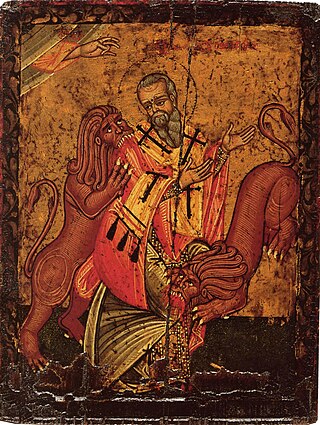
The word catholic comes from the Greek phrase καθόλου 'on the whole, according to the whole, in general', and is a combination of the Greek words κατά 'about' and ὅλος 'whole'. The first known use of "Catholic" was by the church father Saint Ignatius of Antioch in his Letter to the Smyrnaeans. In the context of Christian ecclesiology, it has a rich history and several usages.

An episcopal polity is a hierarchical form of church governance in which the chief local authorities are called bishops. The word "bishop" here is derived via the British Latin and Vulgar Latin term *ebiscopus/*biscopus, from the Ancient Greek ἐπίσκοπος epískopos meaning "overseer". It is the structure used by many of the major Christian Churches and denominations, such as the Catholic, Eastern Orthodox, Oriental Orthodox, Church of the East, Anabaptist, Lutheran, and Anglican churches or denominations, and other churches founded independently from these lineages. Many Methodist denominations have a form of episcopal polity known as connexionalism.
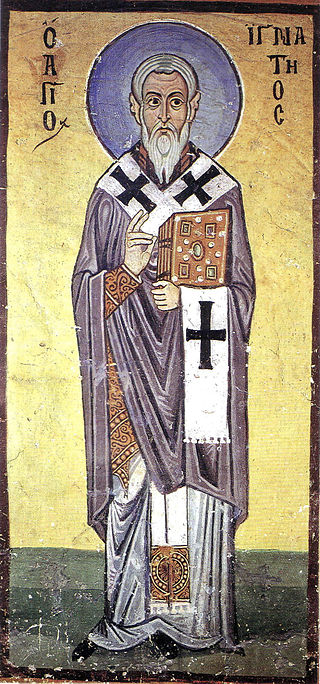
Ignatius of Antioch, also known as Ignatius Theophorus, was an early Christian writer and Patriarch of Antioch. While en route to Rome, where he met his martyrdom, Ignatius wrote a series of letters. This correspondence forms a central part of a later collection of works by the Apostolic Fathers. He is considered one of the three most important of these, together with Clement of Rome and Polycarp. His letters also serve as an example of early Christian theology, and address important topics including ecclesiology, the sacraments, and the role of bishops.
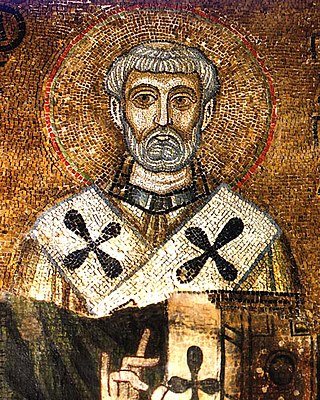
Clement of Rome, also known as Pope Clement I, was a bishop of Rome in the late first century AD. He is considered to be the first of the Apostolic Fathers of the Church, and a leading member of the Church in Rome in the late 1st century.

Enoch is a biblical figure and patriarch prior to Noah's flood, and the son of Jared and father of Methuselah. He was of the Antediluvian period in the Hebrew Bible.

An agape feast or lovefeast is a term used for various communal meals shared among Christians. The name comes from the Greek word ἀγάπη (agape), which implies love in the sense of brotherly or familial affection.
An apostolic see is an episcopal see whose foundation is attributed to one or more of the apostles of Jesus or to one of their close associates. In Catholicism, the phrase "The Apostolic See" when capitalized refers specifically to the See of Rome.
The Apostolic Fathers, also known as the Ante-Nicene Fathers, were core Christian theologians among the Church Fathers who lived in the 1st and 2nd centuries AD who are believed to have personally known some of the Twelve Apostles or to have been significantly influenced by them. Their writings, though widely circulated in early Christianity, were not included in the canon of the New Testament. Many of the writings derive from the same time period and geographical location as other works of early Christian literature which came to be part of the New Testament.

The First Epistle to Timothy is one of three letters in the New Testament of the Bible often grouped together as the pastoral epistles, along with Second Timothy and Titus. The letter, traditionally attributed to the Apostle Paul, consists mainly of counsels to his younger colleague and delegate Timothy regarding his ministry in Ephesus (1:3). These counsels include instructions on the organization of the Church and the responsibilities resting on certain groups of leaders therein as well as exhortations to faithfulness in maintaining the truth amid surrounding errors.

The Apostolic Canons, also called Apostolic canons, Ecclesiastical Canons of the Same Holy Apostles, or Canons of the Holy Apostles, is a 4th-century Syrian Christian text. It is an Ancient Church Order, a collection of ancient ecclesiastical canons concerning the government and discipline of the Early Christian Church, allegedly written by the Apostles. This text is an appendix to the eighth book of the Apostolic Constitutions. Like the other Ancient Church Orders, the Apostolic Canons uses a pseudepigraphic form.

Pentarchy was a model of Church organization formulated in the laws of Emperor Justinian I of the Roman Empire. In this model, the Christian Church is governed by the heads (patriarchs) of the five major episcopal sees of the Roman Empire: Rome, Constantinople, Alexandria, Antioch, and Jerusalem.

The Church Fathers, Early Church Fathers, Christian Fathers, or Fathers of the Church were ancient and influential Christian theologians and writers who established the intellectual and doctrinal foundations of Christianity. The historical period in which they worked became known as the Patristic Era and spans approximately from the late 1st to mid-8th centuries, flourishing in particular during the 4th and 5th centuries, when Christianity was in the process of establishing itself as the state church of the Roman Empire.

The Epistle of Ignatius to the Romans is an epistle attributed to Ignatius of Antioch, a second-century bishop of Antioch. It was written during his transport from Antioch to his execution in Rome. To the Romans contains Ignatius’ most detailed explanation of his views on martyrdom.
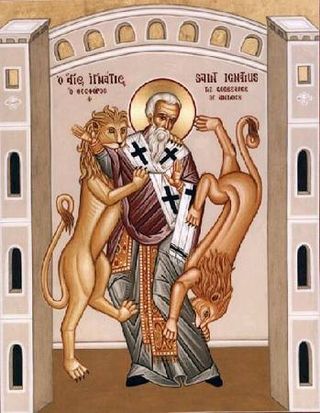
Pseudo-Ignatius was a 4th-century writer who claimed to be Ignatius of Antioch. He is the author of the Ignatian forgeries but he also wrote the Apostolic Constitutions and a Commentary on Job. Harnack also identified Pseudo-Clement with Pseudo-Ignatius. Pseudo-Ignatius has some Arian leanings but is not completely Arian; on the other hand, he in some ways resembles the Apollinarians. However it is not possible to draw clear conclusions on his Christology.
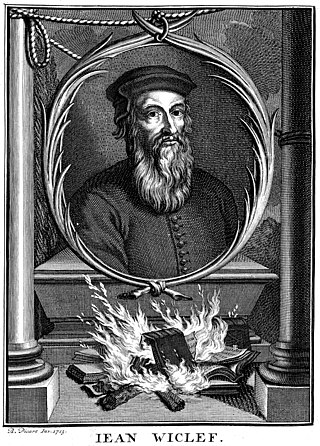
Proto-Protestantism, also called pre-Protestantism, refers to individuals and movements that propagated various ideas later associated with Protestantism before 1517, which historians usually regard as the starting year for the Reformation era. The relationship between medieval sects and Protestantism is an issue that has been debated by historians.
The Book of Enoch, is an ancient Jewish religious work, ascribed by tradition and internal attestation to Enoch, the great-grandfather of Noah. 1 Enoch holds material unique to it, such as the origins of supernatural demons and giants, why some angels fell from heaven, details explaining why the Great Flood was morally necessary, and an introduction of the thousand-year reign of the Messiah. The unique material makes it possible to identify which ancient literary works adopt 1 Enoch as a source. Well known in antiquity, the book was received by various authors with respect, and sometimes considered as divinely inspired.
The Council of Toledo of 447 was the second Council of Toledo. It was a national council held against the Priscillianists, as called for by Pope Leo I. Nineteen bishops participated in the council, which condemned the heresy and the followers of Priscillian and affirmed the earlier First Council of Toledo, on which its Creed is based. It gave a profession of faith against all heretics with 18 anathemas attached against the doctrines of Priscillian. The council is notable for its successful subduing of Priscillianism, expressing a definition of dyophysitism before the Council of Chalcedon, its affirmation of the First Council of Toledo, and being the first known western council to include the "filioque" in its creed, following in the doctrine from Pope Leo I.

Martyrium Ignatii is a work that claims to be an eye witness of the events leading up to his death and the martyrdom of Saint Ignatius.
Philo of Cilicia was a second-century deacon who served in Tarsus, he was mentioned by Ignatius of Antioch in his letters to the Smyrneans and Philadelphians. He accompanied Ignatius of Antioch during his journey to Rome.
References
- ↑ "Philip Schaff: ANF01. The Apostolic Fathers with Justin Martyr and Irenaeus - Christian Classics Ethereal Library". www.ccel.org. Retrieved 2022-06-18.
- ↑ "Henry Wace: Dictionary of Christian Biography and Literature to the End of the Sixth Century A.D., with an Account of the Principal Sects and Heresies. - Christian Classics Ethereal Library". www.ccel.org. Retrieved 2022-06-18.
- ↑ "Ignatius of Antioch". www.earlychristianwritings.com. Retrieved 2022-06-18.
- ↑ Fathers, Apostolic (2009-06-01). The Apostolic Fathers. Moody Publishers. ISBN 978-1-57567-331-8.